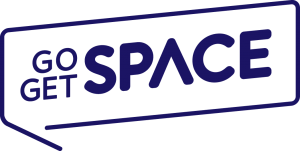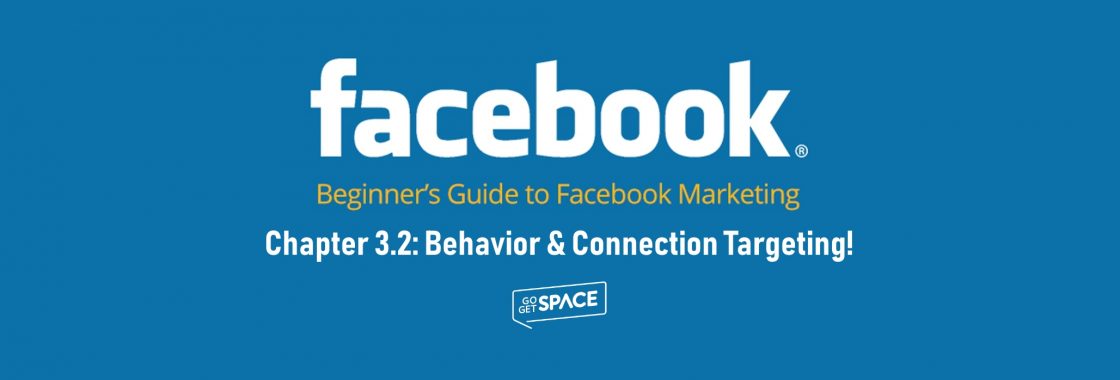As I said before, targeting or defining your audience from the 2+ billion users of facebook is the most tricky part of creating a facebook ad.
Till now, we’ve learnt the basic and straightforward steps of targeting your audience, through location, age, gender, demographic and so.
These are pretty self explanatory and don’t have much tricks in themselves.
Things get tricky when we go to the comparatively advanced steps, which is interest targeting, behavior targeting, connection targeting and so.
You already have understood it if you’ve gone through the previous lesson which was focused on interest targeting. Didn’t it feel a little tricky than the previous targeting options?
Well, we got more tricky things coming up – behavior targeting and so.
My goal with this lesson is to go deep and easy into behavior targeting so that you can understand things better and it doesn’t feel tricky to you anymore.
But before that, I recommend checking out the previous lessons of this course if you haven’t done so. Because it’s tough to understand a continuous process if you skip a step, or steps.
Previous lessons can be found here.
- FaceBook Marketing ABC – Part (1.1) – Introduction and The Basics!
- FaceBook Marketing ABC – Part (1.2) – Introduction and The Basics Continued!
- FaceBook Marketing ABC – Part (2) – Getting Started With Ad Account!
- FaceBook Marketing ABC – Part (3.1) – Let’s Create an Ad
Alright, now let’s get into behavior targeting.
Table of Contents
Refining Audience with Behavior Targeting
What do we mean by behavior?
Activities that people do on Facebook?
Well, yes. But that’s not all though.
When we talk about behavior targeting of facebook, we can take into account the activities that people do even “OFF” facebook, and that’s true.
Now, I don’t want to go to the ethical or moral perspective of facebook looking after users even when they’re not on facebook, I’m gonna accept things as it is, because we’ve got to do our marketing and earn money, don’t we?
Examples of behavior targeting could be ordering a magazine subscription or even spending an above-usual amount of time online.
Also, facebook takes into account user’s offline activity, data of which is provided by variety partners of facebook. This offline activity information could be purchasing behaviors, life events and so.
In sum, to construct a user’s behavior profile, facebook considers on-facebook activities, off-facebook but internet activities and offline activities as well, and mashes them together to create an effective behavior profile.
Now that we understand the concept, let’s see how we can utilize the power of such a behavior profile.
So here we are, still in our ads create tool where we had our other targeting options set.
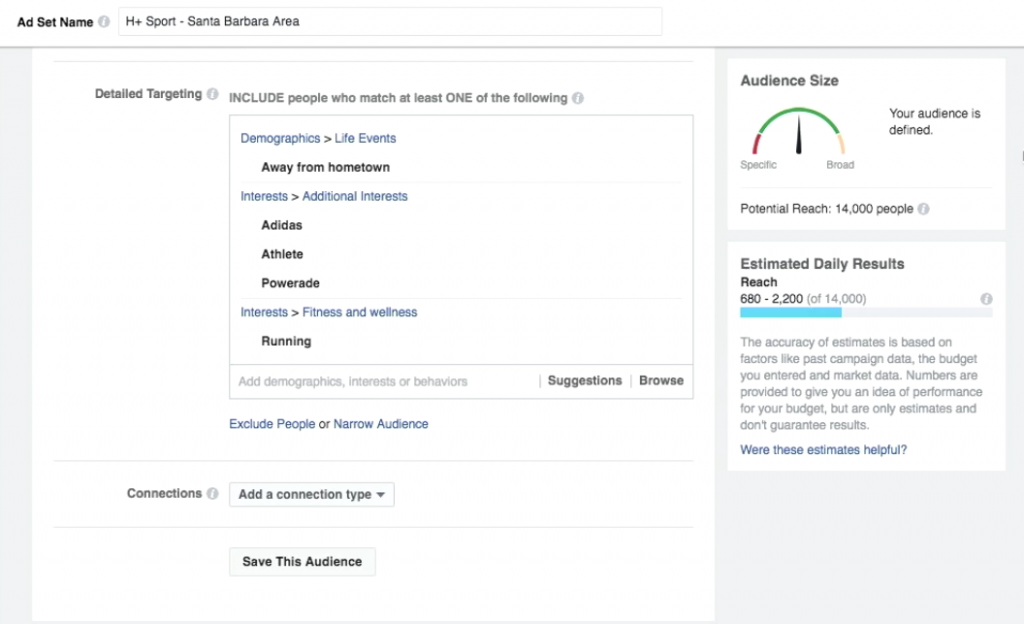
Now we’re going to target through behaviors under the detailed targeting option section.
You can enter behavior options just like the way you entered interests. You can simply click within the search behaviors box and begin typing to browse behaviors.

Or you can click the “Browse” button, then click “Behavior” to browse the behavior options.
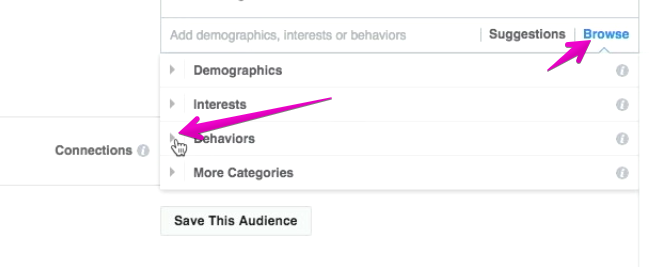
As we did on interest, we can click on the left-hand arrow to open up subcategories under each category.
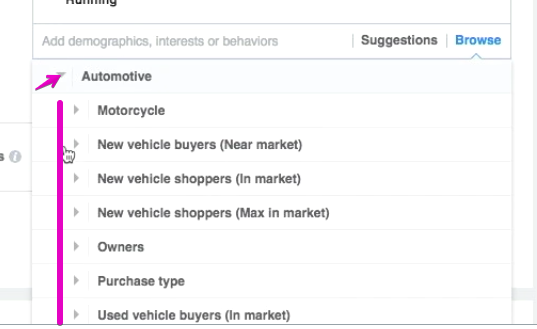
Anyways, behaviors are tricky because there’s no guarantee that the information here is 100 percent accurate, as they’re often collected from third party source. So you’d want to test your options to figure out what works for you.
Now, let us go ahead and select some behaviors for our ad.
Since we’re selling a sports drink, we want to target people that are known to buy other sports products.
For that, I’ll go into “Purchase Behaviors ” and look for “Sports and Outdoors”.

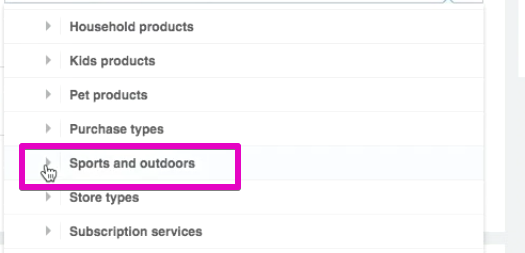
Then we’re going to select “Running”.

Selecting running, this means we’re targeting people that usually buy running products, which facebook figured out based on their past purchasing profile.
So, as we selected “running”, it has been populated with the interests and demographics that we’ve selected already.
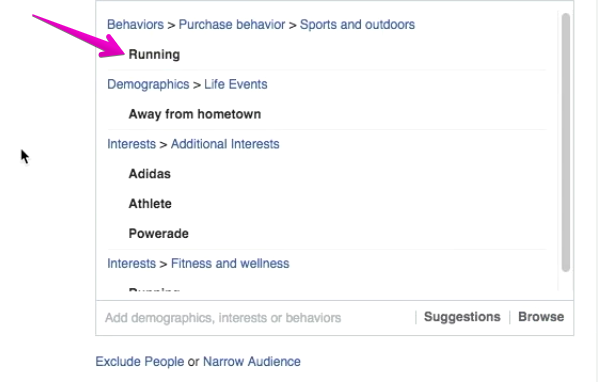
Let’s go ahead and select another behavior.
So I’m going to select “digital activities” and then choose ‘console gamers’, as they often buy our drink according to our past records.
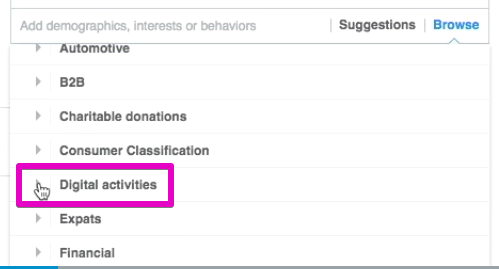
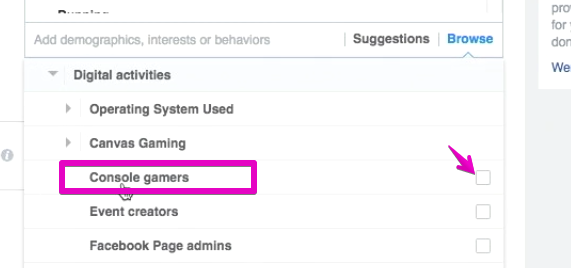
As you can see, it has been added along with my other targeting options.
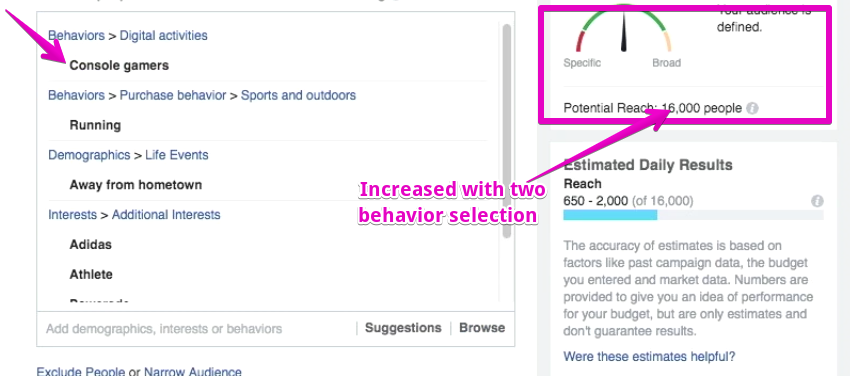
This two behavior has an “and/or” relationship between them, means our ad will be looking for either user with past purchase profile around running drinks and products, or for console gamers, or for someone with both.
But, these two behavior combined have an “and” relationship with other targeting methods we’ve selected for this ad.
Targeting Through Connections
The next targeting method facebook offers us is through connections.
Connection targeting is for controlling whether you want to show your ad to someone with whom you somehow have a connection (direct or indirect) or not.
You have various options to choose from like other targeting methods.
For example, you can identify people who already have liked your page, and show the ad to them. Or, you can also exclude them – means even if they meet your other targeting parameters, they won’t be shown the ad.
You may do something like this when you’re trying to increase the number of likes on your page. In this case, there’s no point to target people who already like your page, right?
Let’s see how connection targeting actually works and how to set it.
So, when you click the button “Add a connection type”, you get a drop-down menu with four options.
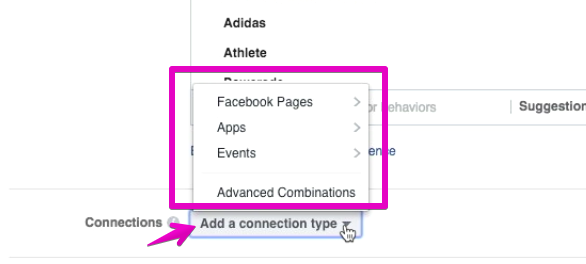
The options here are “facebook pages”, “apps”, “events”, and “advanced combinations”. Let’s see what’s there under each option.
So, when we select facebook pages, we get three options here.
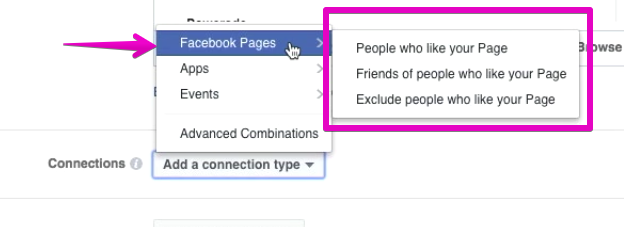
That is –
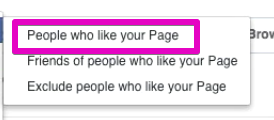
“People who liked your page” – means you can identify people who’re already connected with your page, as I mentioned above.
Selecting this option, you’ll be targeting those people meets other targeting parameters that you’ve set, and are also connected to your page.
The next option is “Friends of People who liked your page” – you understand what this means.
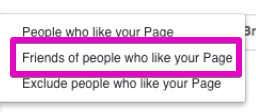
You’ll be targeting all those people that are in the friend-list of the people that are already connected to your page.
This is useful from the perspective that people in a particular person’s friend-list are likely to have similar interest.
So if that person is interested in and connected to your page, his/her friends might be interested in your page too.
The last option is – “Exclude People who like your page” – as I said above.

When you select this option, people that like your page will be excluded from the list of people that facebook has set up according to your other targeting parameters.
When you want new and fresh contact, you may select this option. But usually, when someone runs an ad, he/she usually targets the people that are connected to his/her page, as usually that page is created/designed to attract his/her potential customers.
So targeting those customers more with ads seems like a better option.
But when your goal is to increase the likes of your page and so, you may want to select this option as I mentioned above, to not waste money by showing the ad to people who are already been converted.
The next connection type is “Apps”. You might be connected with your audience through apps and you can choose any of these three options below to determine what to do with that connection.

Now, the options here are very similar to “facebook pages” options.
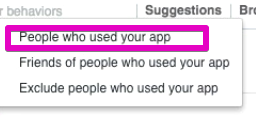
The first option says – “People who used your app” – means you’re targeting people that have used your app at some time. You usually choose this option when you want to convert your users.
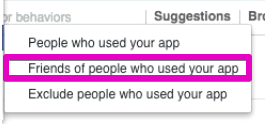
The next option says – “Friends of people who used your app” – means you’re targeting the people that are in the friend-list of the users of your app. You usually choose this option when you want to gain more users, and convert them later maybe.
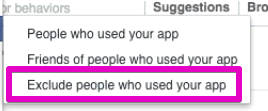
The third option says – “Exclude people who used your app” – means you’re excluding your existing users from the ad even if they meet other targeting parameters.
You usually choose this option when you’re running ads to gain more new and fresh users, so you don’t want to waste money by showing the ad to your already gained users.
The final connection type we can use is “Events”. Facebook identifies which people are already connected with our event and let us decide what to do with them.
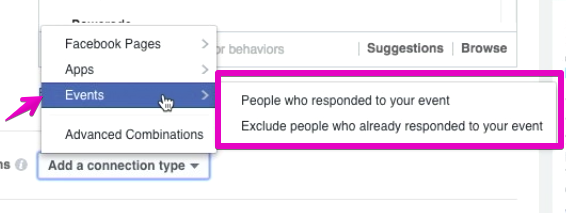
Here, you get two options, unlike the three for pages and apps.
For the first option – “People who responded to your event”, you can target people that are “going” or “maybe” to your event.

Or, you can exclude the people who’ve responded to your event.

This is the option you choose when you want more unique responses to your event.
There’s one more option you’ll find in the drop-down menu which is “Advanced Combination”.

Previously, when we were taking ‘pages’ or ‘apps’ or ‘events’ into concern, we had to pick only one from the available options.
That is – either to show the ad to a connected page or app or event, or to exclude the connected people, or to show the ad to friends of the connected people of the entity (page, app or event).
What if, you want to show an ad to the connected people of your page, and their friends also? You certainly can’t do that selecting from “Pages” options, as you have to choose only one.
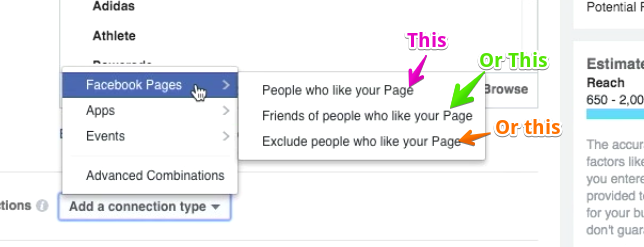
For this kind of cases, you want to choose ‘advanced combinations’. You want to type in the page name in both the boxes like below to target both groups of people.
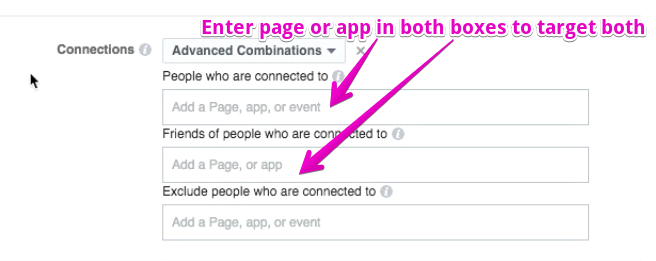
You may do the same to app or events as well. Though you can enter an event in the middle box titled “Friends of people that are connected to” – because if you remember there was no such option when we chose the “event” perspective.

However, to push things further, you can take multiple pages, app or event in concern and create a connection targeting mix.
Let’s say, you have “page 1”, “page 2”, “app 1”, “app 2”, “event 1”.
You want to target people connected to “page 1”, “app 1”, and friends of people connected to “page 2”, “app 2”, and exclude people connected to “event 1”.
Seeming complex? Let’s see it by putting them in the boxes.

Seems simpler now?
This was just an example. You can do the same if you have multiple entities to take into concern.
However, usually, regular advertisers do not have to make such combinations or go through such a process. Only advanced and large advertisers that deal with a lot of stuff make such practices.
And I also recommend the newer advertiser to leave this option so that you have to have fewer variables in mind which will make things simpler for you to evaluate.
One thing I need to mention here is, you can only use those pages or apps or events to target or exclude people that you own or are an admin of. You can’t just take any page of facebook into concern and target its audience.
Okay, It’s a Little Quiz Time
I hope I could make behavior targeting and connecting targeting methods clear to you. If it so, could you answer these simple questions?
Question: Suppose you have an app. How can you utilize the audience connected to it?
- Target them for your ad
- Target their friends for your ad.
- Exclude those group of people from your ad
- None of these
- All of these
Question: How Facebook constructs a user’s behavior profile?
- By Activities on Facebook
- By activities off facebook but on internet
- Offline activities
- All of these
Question: Can you target the friends of the people that have responded to your event?
- Yes
- No
Question: Which connection targeting option you’ll choose when you have to take multiple entities (pages, apps, events) into concern?
- Facebook pages
- Apps
- Advanced combination
- Events
That’s All For This Lesson
Let’s wrap this lesson up here. Hopefully, now you have the knowhow to filter your audience with behavior and connection targeting.
This is a tricky part of facebook ads, so I encourage you to research more by yourself to know more on this topic.
In the next lesson, we’ll learn a very important stuff – how to set budget for your ads. The upcoming lessons will also focus on How to choose your ad creative, you to write your ad copy and so on.
Aren’t you excited to learn more awesome stuff?
Stay tuned. The link of the next lesson will be update here as soon as it’s published.
